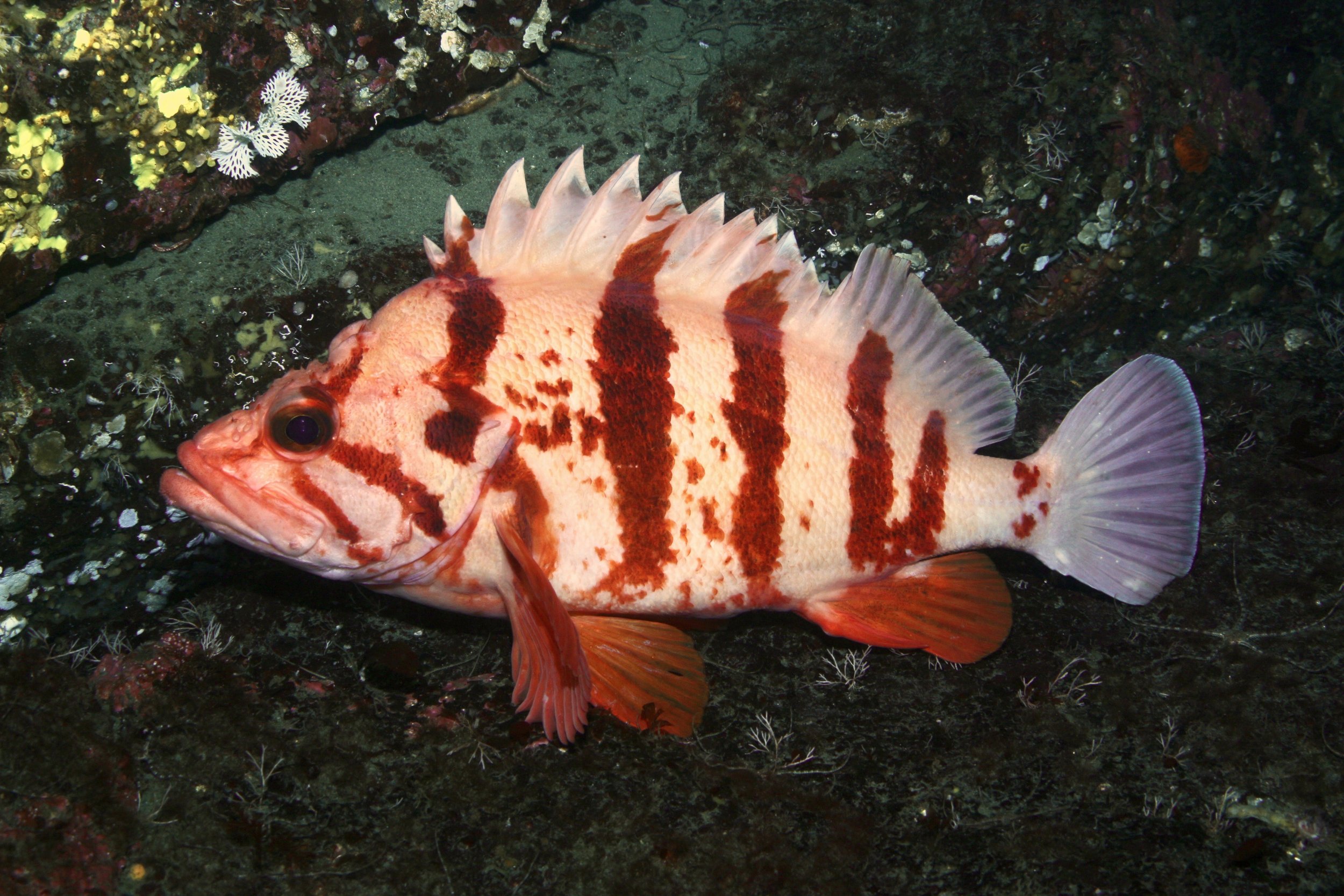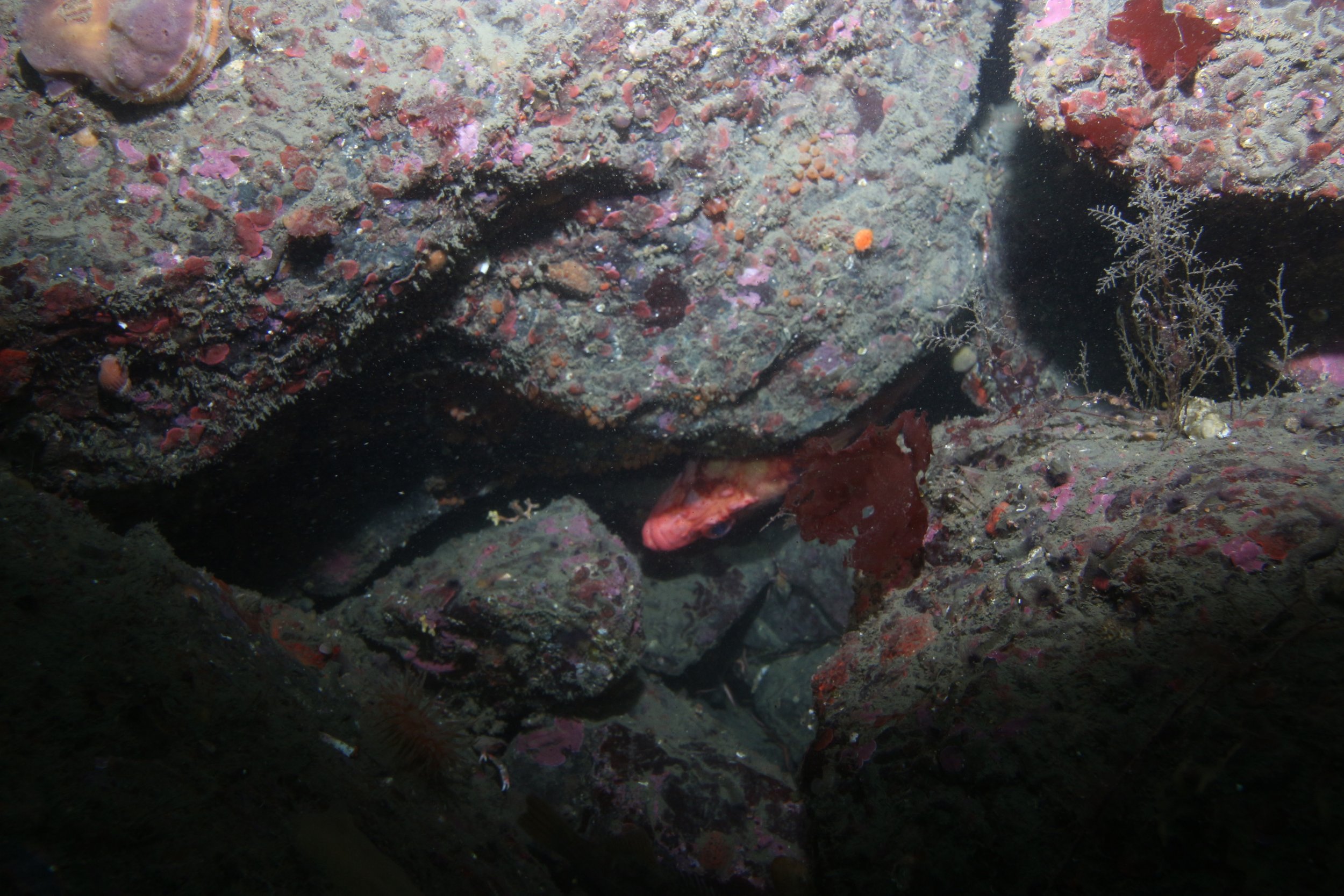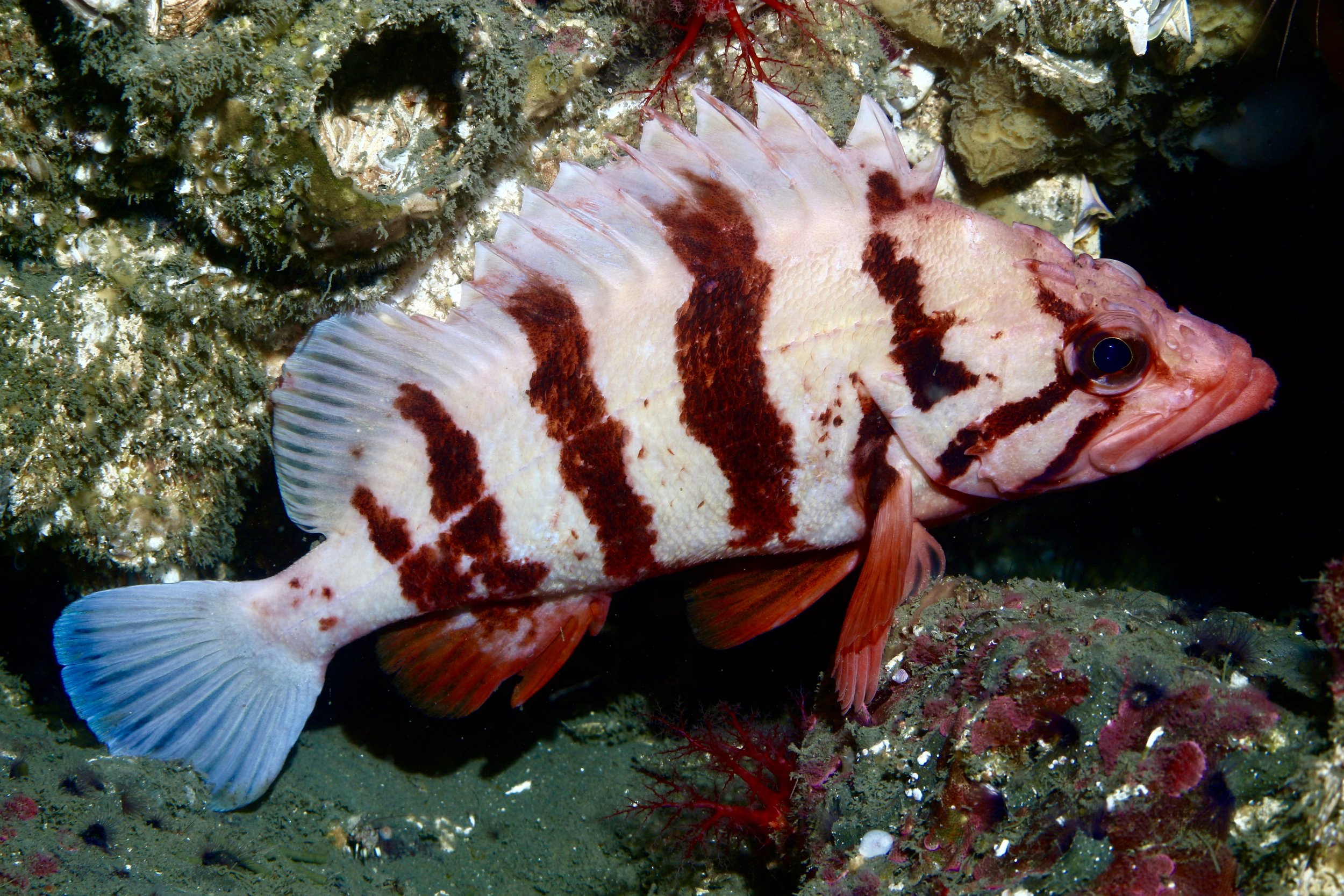Tiger Rockfish
Sebastes nigrocinctus
The Tiger rockfish is a cultural staple among divers, naturalists, and researchers. No doubt due to it’s striking colours and patterns, which are often in stark contrast to the animal’s surroundings. Belonging to the rockfish genus, the appeal of this species to biologists extends far beyond its initial appearance.
Like many other rockfishes, the Tiger rockfish is extraordinarily long lived and has a fascinating life history. In some areas, naturalists have been able to return to the same sites year after year and regularly encounter the same individuals. Many of this animal’s characteristics have left it particularly vulnerable to overfishing.
This artwork is inspired by my photo of the Tiger rockfish below:
November 2019: An adult Tiger rockfish graces my dive team with a rare opportunity to photograph them completely out in the open. Tiger rockfish are typically very reclusive and spend most of their time tucked away in cracks and crevices within their territory. Photographed off of Madrona Point in Nanoose, B.C.
📖 Description 📖
The Tiger rockfish lives up to its name in many contexts; upon first glance, it is clear that the name is derived from the tiger-like vertical stripes that run the length of the animal’s body. The black stripes of a Tiger are thought to be a form of disruptive colouration, which is a form of camouflage that serves to ‘break up’ the outline of an animal in order to further blend in with its surroundings. It is possible (but not confirmed!) that these stripes serve a similar purpose for the Tiger rockfish. In addition, this species is also known for establishing and defending territories, and is considered a fierce predator by many [1].
Tiger Rockfishes grow up to a total length of 60cm, and can weigh up to 2.2kg, making this one of the larger species in the rockfish genus. These incredible fishes have been documented to live for up to 116 years or longer [1]! To help the Tiger rockfish reach such an incredible lifespan, they are equipped with sharp, venomous spines on its dorsal fin to deter predators, and are notoriously cautious. Tiger rockfishes are most often sighted deep within safe crevices in the reef, as seen in the photograph below:
October 2019: A more typical Tiger rockfish sighting, with their head just barely visible behind a collection of boulders. Also photographed at Ogden point, Tiger rockfish are often seen here as the rocks from the breakwater make excellent habitat.
🌎 Distribution 🌎
Tiger rockfishes are a Northeast Pacific specialty, encountered as far north as the Aleutian Islands in Alaska, and as far south as Southern California. There is interestingly one isolated sighting of a Tiger rockfish in the Sea of Okhotsk in the Russian Far East [2].
Distribution of the Tiger rockfish, Sebastes nigrocinctus. Suitable habitat depicted in red.
🏝 Habitat 🏝
Tiger Rockfish also live up to the 2nd half of their name, demonstrating a very strong preference for habitats featuring large boulders, rocky walls, and crevices. While they can be sighted on almost any rocky reef, they are encountered more often in habitats that are subjected to high currents. As this species is sedentary and does not move a great deal from its territory, they will often rely instead on the currents to bring them prey as opposed to hunting for it themselves [3].
October 2018: A smaller Tiger rockfish anxiously perched on a rock directly in front of their shelter. Moments after taking this shot, the fish darted into the safety of a rocky crevice. Photographed off of Ogden Point in Victoria, B.C.
This species is considered one of the ‘deep-water’ rockfishes, and can be encountered anywhere between 10 and 300m beneath the surface of the sea [1].
Depth of suitable habitat for the Tiger rockfish, Sebastes nigrocinctus. Suitable habitat depicted in red. Not to scale
🦀 Diet 🦀
Tiger rockfish are generalist predators, feeding opportunistically on whichever type of prey is most readily available at the time. They are thought to take particular advantage of events such as the Pacific herring spawn and juvenile salmon migration, as these can bring large numbers of small fish in close proximity to reef habitats. When prey fish are not present, the Tiger rockfish will preferentially hunt crab species such as the Red rock crab [3]. While fish is generally considered to be more nutritious and calorie-dense than crab, it is not well demonstrated if Tiger rockfish have a preference.
October 2016: An impressive school of juvenile Pacific herring pass over a rocky reef in Saanich Inlet, B.C. There were no doubt hungry rockfish of many different species snapping away at this school over the course of its passage through the region.
🐠 Life Cycle 🐠
Like all members of the Sebastes genus, Tiger rockfish are a live-bearing fish, meaning that they give birth to live young instead of laying and caring for eggs. Some other local fishes, such as the Surfperches give birth to young that resemble miniature adults. Instead, rockfishes give birth to larval fish who begin their lives by swimming out to sea to begin their lives as plankton. After approximately two months, they locate and settle down on rocky reefs as juveniles [3].
It can take up to 8 years for male and female tiger rockfishes to reach sexual maturity, which makes them particularly vulnerable to overfishing, as it takes significantly longer for populations to rebound after intense fishing pressure. By comparison, Lingcod reach sexual maturity and begin reproducing in 3-5 years [4].
September 2017: Yet another Tiger rockfish sighting at Ogden Point. Given their long lifespan and sedentary lifestyle, it is possible to return to the same location and visit the same rockfish.
📚 References 📚
[1] FishBase, (n.d.). Sebastes nigrocinctus (Ayres, 1859). Retrieved March 23, 2023, from https://www.fishbase.se/summary/SpeciesSummary.php?ID=3985&AT=tiger+rockfish
[2] World Register of Marine Species. (n.d.). Sebastes nigrocinctus (Ayres, 1859). Retrieved March 23, 2023, from https://www.marinespecies.org/aphia.php?p=taxdetails&id=274825sadf
[3] Race Rocks Ecological Reserve. (n.d.). Sebastes nigrocinctus: Tiger rockfish – The Race Rocks taxonomy. https://racerocks.ca/sebastes-nigrocinctus-tiger-rockfish-the-race-rocks-taxonomy/sdf
[4] Lang, V. & Stock, C. (2007). Lingcod. Alaska Department of Fish & Game. https://www.adfg.alaska.gov/static/education/wns/lingcod








